Glossary of Australian rules football
This list is an alphabetical glossary of Australian rules football terms, jargon and slang. While some of these entries are shared with other sports, Australian rules football has developed a unique and rich terminology.
.jpg)
Australian rules football is known by several different names, including footy and Aussie rules.
Where words in a sentence are also defined elsewhere in this article, they appear in italics.
0-9
- 1-2: (pronounced one-two) an action where a player handpasses to a teammate, who immediately handpasses back.
- 12-10 Rule: Formerly a rule in the VFL concerning the selection of AFL-listed players in teams with an AFL affiliate team. When a team which is affiliated with an AFL team plays against a team which is not affiliated with an AFL team, the affiliated team must play at least 12 VFL-listed players and no more than 10 AFL-listed players. The 12-10 rule does not apply when two AFL-affiliated teams play each other, and in those games, teams may play as many AFL-listed players as they wish. This rule has since been abolished.
- 19th man: at a time in the game before the substitute bench was introduced in 1930, one reserve player was named in addition to the 18 players who started the game on the ground. These players could enter the game only if one of the original 18 left the field and did not return. This was also extended to the 20th man when a second reserve was introduced in 1946. Free interchange of the 19th and 20th players has been allowed in the VFL since 1978.[1] This can also refer to the philosophy of the South Australian crowd being the 19th man for the Adelaide Crows, who have retired the number 19 guernsey, and sell sporting merchandise with the number 19 on it.
- 50-metre penalty: advances the attacking team forward by fifty metres after an opposition player has committed an infraction such as pushing his opponent in the back after a mark has been paid, or time wasting.
A
- Advantage paid: umpiring decision in which play continues after an infringement if the team with the ball is infringed upon; rather than stop play to award the free kick, the umpire allows play to continue so as not to disadvantage the attacking team.
- Aerial ping-pong: slang term for the sport in general, specifically used to refer to a game in which teams exchange long-distance kicks across the centre of the ground, like table tennis players batting the ball back and forth.
- AFL: Australian Football League. This acronym is used colloquially as an alternative name for the sport when distinguishing it from other football codes, particularly in Queensland and New South Wales.
- After the siren: a set shot for goal after the final siren has sounded.
- All-Australian: a player who has been chosen in the best team of the AFL competition each year, the All-Australian Team; or, prior to the nationalisation of the competition or in lower age groups where the game is not nationalised, the best composite team from all states based on performances at an interstate carnival.[2]
- Angle: the geometric angle formed by an imaginary line between a player taking a set shot and the centre of the goals (on the goal line), and another imaginary line perpendicular to the goal line. So, a player with "no angle" is taking a kick from directly in front; a player on a "wide angle" is taking a shot from near a boundary line.
- Arena: the playing surface.[3]
- Assist: to kick or handpass to a player who then scores either a goal (for a goal assist) or a behind (for a score assist). The term is common across many world sports.
- Australian football: name officially used by the AFL for the sport.
B
- Bag: colloquialism for five (5) or more goals scored by one player.[4]
- Ball!: usually yelled by spectators when an opposition player is tackled in possession of the ball. Short for "holding the ball".[3]
- Ball burster: colloquialism for a massive kick, usually a torpedo punt which travels over 70 metres.[5]
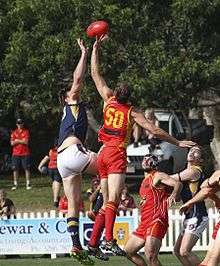
Ruckmen contesting a ball-up
- Ball-up: the act of a field umpire putting the ball back into play, either by throwing it vertically upwards into the air, or by bouncing the ball in such a way that it mimics the throwing action. See bounce-down. A ball-up is required at the start of each quarter, after a goal is scored or to restart the game from neutral situations in the field of play.[3][6]
- Banana: see checkside.[7]
- Banner: a large crêpe paper and sticky-tape banner that players run through prior to a match.
- Barrack: to cheer for a team. A fan is known as a "barracker", while to ask someone who they barrack for is to ask which team they support.
- Barrel: see torpedo.[8]
- Baulk: a manoeuvre where a player holds the ball out to the side in one hand, then runs in the other direction to evade a defender.[9]
- Behind: a score worth one point, earned by putting the ball between a goal post and a behind post, or by the ball hitting a goal post, or by the ball being touched prior to passing between the goalposts.[3]
- Behind posts: two shorter vertical posts 19.2m apart on the goal line at each end of the ground, centred about the taller goal posts.
- Bench: the interchange area. The "bench" refers to the seat used by the players in this area.[10]
- Best on ground: player judged the best player taking part in any game. Sometimes also referred to as BOG, pronounced "bee-oh-gee".[11]
- Big dance: colloquial term for a grand final.
- Blinder: an exceptional performance by a player or team.
- Bounce-down: (or simply bounce) the act of a field umpire putting the ball back into play by bouncing the ball in such a way that it mimics a vertical throw. See ball-up.[12]
- Boundary line: the line drawn on the ground to delimit the field of play.[3]
- Boundary throw-in: (or simply throw-in) the act of throwing the ball back into play by the boundary umpire. The boundary umpire stands facing away from the field and throws the ball backwards over their head. This is used to restart play from neutral situations whenever the ball goes out of bounds.
- Boundary umpire: an official who patrols the boundary line, indicating when it has fully crossed the line, and who then executes boundary throw-in to return the ball to play. There are typically two of these umpires per game, one on each side of the oval, but there will be four in top grade games.[3]
- Break: short for "break in play"; e.g. quarter-time, half-time, or three-quarter-time.[13]
- Brownlow: the Brownlow Medal is awarded the week of the Grand Final to the player judged to be the fairest and best player in the league for the season, based on accumulated votes awarded by the field umpires at the conclusion of each match during the season.
- Bump: a contact between players using the hip and/or shoulder.
C
- Centimetre perfect: a phrase commonly used by former commentator Dennis Cometti to refer to a kick that could not have been placed any better.
- Central umpire: an official who patrols the field of play, awarding free kicks, indicating time-on and time-off, and restarting the game after stoppages, goals etc.
- Centre: the middle of the ground, also the name given to a player who starts the game in that position.
- Centre bounce: the bounce of the ball in the centre of the ground to start a quarter, or after a goal.[6]
- Centre square: a fifty-metre square drawn around the centre of the ground. Only four players from each team may stand inside the centre square prior to a centre bounce, but the square otherwise has no significance.[3]
- Charlie: colloquialism for the Brownlow Medal.
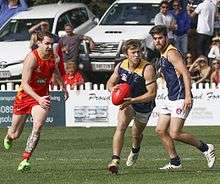
Defensive player giving chase to an attacking player with the ball
- Chase: the act of a defensive player running after an attacking player in possession of the ball.
- Checkside: a kick which causes the ball to swing in the air in the opposite direction to the usual. See banana.
- Chicken wing tackle: a tackle that locks in an opponent's arm so that he cannot legally dispose of the ball. This term originated in Rugby League.
- Clanger: a blatant, unforced error. This can be conceding a free kick, or kicking or handpassing the ball directly to an opponent or dropping an uncontested mark.
- Clearance: the clearing of the ball out of a stoppage situation, to the advantage of one team or the other.
- Cluster: a type of zone defense consisting of a grid-like arrangement of fifteen or more players, particularly used to oppose a kick-in.[14]
- Coach: the manager of the team who controls the team's tactics during a match.[6]
- Coast-to-coast goal: a passage of play beginning with a kick-in and ending with a goal, with the ball untouched by an opponent.
- Coathanger: a dangerous high tackle, generally with a slinging arm around the head or neck of an opponent.
- Contest: an in-game scenario where two or more players have an opportunity to win the ball.

Player gains possession in a marking contest
- Contested possession: a possession achieved as a result of winning a contest. Includes hardball gets, looseball gets, contested marks, free kicks won in a contest, and contested knock-ons.
- Corkie: colloquialism for a corked muscle, which is a deep bruise, usually in the leg.[15]
- Corridor: the imaginary strip of the ground that runs through the centre from goal to goal; a team who moves the ball in this area is said to "play through the corridor".[14]
- Crow throw: a handball technique which involves using a significantly shorter arm swing from the punching hand. The style was somewhat unique to South Australia in the SANFL, in interstate and State of Origin matches and ultimately to the Adelaide Crows. As a result, interstate the technique was given the pejorative name crow throw (derived from croweater, a common name for South Australians).

Player (foreground) moving in to collect the crumb from a contest
- Crumb: a ball that spills loose from a contest. A player who collects the crumb is described as a "crumber", or "getting the crumbs". To "crumb a goal" is to score after getting the crumbs.[16]
D
- Daisy cutter: a kick that runs along the ground rather than through the air. See grubber. Also may to refer to a drop punt in which the ball travels through the air, but low to the ground.
- Deliberate: a free kick awarded against a player who is perceived to have deliberately sent the ball out of bounds.
- Designated kicker: a player who is given the ball by another player who has a set shot for goal, so that the receiving player may have a shot on the run for a long-distance goal or a supergoal. Typically done when the designated kicker is known to have a better likelihood of scoring the goal than the player taking the set shot.
- Disposal: passing the ball legally, via a handball or kick.
- Don't argue: colloquial term for a stiff-arm fend.
- Dribble goal: a goal kicked using the grubber technique. It is often utilised from the boundary line at a tight angle with players manipulating the bounce of the ball to bend it through the goals.
- Drop kick: a kick that is executed in such a way that the foot contacts the ball at the same time as, or immediately after, it has been dropped to the ground on its end. No longer in common use in AFL due to its perceived inaccuracy. See stab pass.
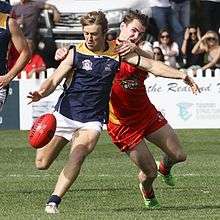
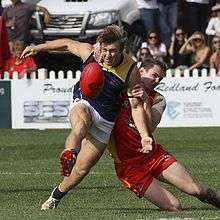
Player executes a drop punt
- Drop punt: a kick that is executed by contacting the ball on its end, so that it rotates around its midpoint end over end. Usually considered the most accurate of kicks, and is by far the most commonly used kicking style in Australian rules football.
- Dropping the ball: see holding the ball.
E
- Emergency umpire: a qualified field umpire who sits on the interchange bench during a game. He can pay free kicks only for interchange infringements and may report players, and can replace an injured or fatigued umpire.
- Evasion: when a player in possession of the ball manages to avoid being tackled.
F
- Falcon: To be hit by the ball in your face or head.[17]
- Fat side: an imaginary area of the ground that indicates the greatest space occupied by the fewest players. See thin side.

Field umpire
- Field umpire: see central umpire.
- Fifty: short for "fifty-metre penalty".
- Fifty metre line: an arc drawn at each end of the ground indicating that the distance from the goal line is fifty metres.
- Fifty metre penalty: extra 50m of field position awarded to a player following a mark or free kick when an opposition player infringes after the mark/free kick is paid.
- Final siren: the siren that sounds to signal the end of the game.
- Finals: the post-season series of games that decide the premiership.
- Fixture: the schedule of matches to be played over the course of the season.
- Flag, the: common expression for the Premiership, based upon the practice of awarding a flag for winning the premiership (analogous to the pennant in American sports).
- Flags: white flag waved by a goal umpire to signal a goal or behind.[3]
- Flank: an indicative area of the ground that lies between the wing and pocket on both sides of the centre. Also referred to as "half-forward flank" and "half-back flank".
- Flick pass: the variant of a handball in which the ball is propelled with a flick of an open hand, rather than a clenched fist. Flick passes were formerly legal, but are now considered a type of throw.[18]
- Flight: the way a ball travels through the air.
- Flood: the act of getting as many players as possible between the ball carrier and the goal a team is defending.[14]
- Follower: an old term referring to an on-the-ball player, so named because they were the only players who followed the ball wherever it went. Specifically, the ruck, ruck rover and rover were considered followers. The term is less applicable in the modern game, where many more players will tend to move around the ground.

A football, known colloquially as a footy
- Footy: slang term for Australian rules football. Also used to describe the ball itself.
- Four points, to get the: common parlance for winning a game. The "four points" refers to the number of premiership points awarded for a win in an AFL game and in many other leagues. "To get the two points" would be the South Australian equivalent.
- Free kick: a possession of the ball given to a player as a result of an infringement by an opposition player. These are only awarded by the central umpire.
- Full-back: the area of the ground directly in front of the opposition's goals. Also the name given to the player placed in that position. Usually opposed by the full-forward.
- Full-forward: the area of the ground directly in front of a team's goals. Also the name given to the player placed in that position. Usually opposed by the full-back.
- Full-time: the end of the game. See final siren.
G
- Goal: a maximum score (equivalent to 6 points) achieved by kicking the ball between the two goal-posts without it touching either post or any other player.[3]
- Goal line: a section of the boundary line that runs from one behind post to the other, at each end. All four posts (two goal posts and two behind posts) are set directly on this line.[3]
- Goal posts: two tall posts at each end of the ground indicating the major scoring zone, positioned 6.4m apart.[3]
- Goal square: the 6.4×9m rectangle drawn on the ground directly in front of each goal.[3]
- Goal umpire: an official who adjudicates the score, signals the score (out-of-bounds, behind, or goal), waves flags to indicate the score to the crowd, and serves as official scorekeeper. There are two of these umpires per game, one at each end.[3]
- Gorilla: colloquially, a large, strong defender who plays body-on-body defence against the strongest forwards.
- Grab: see mark.
- Grand final: the conclusive game of a finals series that decides a league's premiership-winning team.
- Granny: see grand final.
- Grubber: a kick that runs along the ground rather than through the air. See daisy cutter.
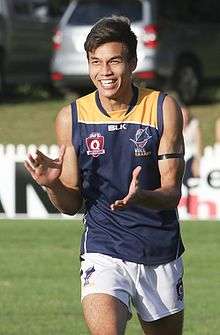
Player wearing a guernsey
- Guernsey: the shirt worn by players, typically sleeveless and occasionally with long sleeves.
- Guts, the: colloquial term for the corridor.
H
- Half-back: the area of the ground lying halfway between the centre and full-back. Also the name given to the player placed in that position. Usually opposed by the half-forward.
- Half-forward: the area of the ground lying halfway between the centre and full-forward. Also the name given to the player placed in that position. Usually opposed by the half-back.
- Half-time: the long break between the second and third quarters.[13]
- Hammy: a severe hamstring injury (as in "pulled a hammy"). Also hammie.

Player preparing to handball
- Handball: (or handpass) a disposal of the ball, executed by holding the ball on the flat palm of one hand and hitting it with the other clenched fist.[3]
- Handy point: colloquial term for a behind scored near the end of a close game which extends to one more than a multiple of six (i.e. from six points to seven points, from twelve points to thirteen points, or from eighteen points to nineteen points); so called because it means the opposition needs an extra scoring shot to tie or win the game.
- Hanger: see spectacular mark.
- Hard ball get: see contested possession.
- High tackle: a tackle that results in contact to the opposition play over the top of their shoulders or to the neck or head. This will result in a free kick.
- High flyer: see spectacular mark.
- Hip-and-shoulder: see bump.
- Hit the woodwork: see poster.
- Hitout: Knocking the ball out of the ruck contest following a stoppage with clear control, regardless of which side wins the following contest at ground level.
- Holding the ball: a free kick awarded to a defensive player who tackles an opponent and prevents him from legally disposing of the football.
- Holding the man: a free kick awarded to a player tackled while not in possession of the ball.[19]
- Hospital kick: a very high kick to a teammate, allowing opposition players to run in and crash into the person attempting to mark the kick. Can also be a hospital pass.
- Hot spot: the point at the top of the goal square where the contest for the ball is fierce.

Players in a huddle
I
- In-and-under player: (or inside midfielder) a player who tries to win hard ball gets by forcing the ball out of packs.
- Inside-50: the act of running or passing the ball inside the 50m arc. A statistic that is used to evaluate the effectiveness of midfield players who may not score many goals themselves, but set them up for teammates.[22]
- Interchange bench: The designated area of the ground where players wait to be allowed onto the field after another player has left, i.e. one player is interchanged for another.[3]
- Interchange gate: a 20m zone marked on the boundary line through which players being interchanged must run.
J
- Jumper: see guernsey.
- Jumper punch: where a player takes hold of an opponent's guernsey (or jumper) and then pushes in a punching motion.[23]
K
- Key position: the full-forward, centre half-forward, centre half-back and full-back are collectively known as the key positions, and are considered the most difficult roles to play.
.jpg)
The follow through motion of a kick
- Kick: a legal disposal of the ball by foot. By formal definition, contacting the football with any part of a player's leg below the knee is considered a kick.[3]
- Kick-in: (or sometimes kick-out) the return of the ball back into play after a behind has been scored.[14]
- Kicking in danger: swinging one's leg to kick the ball when an opponent is moving head-first towards the ball.
- Kick-off line: the line on the goal square which is parallel to the goal line.
- King hit: an illegal physical attack on a player behind play, generally to the head which leaves the victim in a dazed or unconscious state.
- Knock-on: when a player using their hands to move the ball to a teammate's advantage—either by knocking it through the air or along the ground—rather than take possession within a chain of play.
L
- Ladder: the position of teams on the Premiership list, determined by their win-loss ratio and percentage.
- Lead: for attacking player who runs into space and away from their direct opponent, hoping to attract a pass from a teammate.
- Leather poisoning: a player who gains many possessions during a game.
- Legging: see low tackle.
- Loose ball get: a disputed ball at ground level not under direct physical pressure that results in an opportunity to record a legal disposal. Counted as a contested possession.
- Loose man in defence: a player who typically spends an entire game without a direct opponent, who assists other defenders in the team when necessary, and is often heavily involved in rebounding.
- Low tackle: a tackle resulting in contact made to a player below their knees. Results in a free kick against the tackling player.
M
- Maggot: used derisively by fans to describe an umpire (umpires traditionally wore an all-white uniform).
- Main contest: Any point of play where the ball is in contest between the opposing players.
- Major: a goal.[13]

Man-on-man
- Man-on-man: the "traditional" defensive style of a defender playing close to an opposition forward. See zone-off.
- Mark: a clean catch of the ball after it has been kicked by another player (either by a teammate or by the opposition), before it has touched the ground, or been touched by any other player, and after it has travelled a minimum of 15 metres. The term also refers to the spot on the ground where the mark or free kick took place.[3]
- Melee: an unacceptable gathering of players involved in deliberate physical contact. Can lead to suspensions and fines.
- Midfield: the area on an Australian rules football field located between the two 50 metre arcs.
- Midfielder: a player who roams and plays within the midfield.
- "Mine!": a call by the field umpire when the football is caught in a contest and in the opinion of the umpire the ball can not escape the contest. The umpire will then perform a ball-up to recommence play.
- Mongrel: a tumbling, awkward-looking kick.
N
- Norm Smith Medal: a medal awarded to the best player on ground in the AFL Grand Final. Usually given to a player from the winners side.
- "Not 15!": a call by the field umpire when the football has been kicked less than 15 metres, indicating that a mark will not be awarded from that kick. Previously "Not 10" before a change in law increased the minimum distance for a mark from 10 to 15 metres.
- Nuggety: refers to a short and stocky player, or a player who makes the most of a limited skill set.
- Nut: colloquialism for the ball.
O
- Odd bounce: In part due to the shape of the ball, where its rotation or spin induces an unexpected bounce direction.
- Off the ball: a physical confrontation between two or more opposing players away from the main contest.
- Off the side of the boot: a kick that misses the proper top surface of the boot (between arch and toe) and is hit with the sloping angle of the foot resulting in a deflected or winged shot.
- On the ball: a player who is not in any set position but who follows the ball all over the ground; also known as a follower or onballer, and not the direct opposite of off the ball.
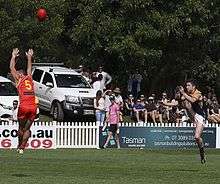
The player on the left is on the mark
- On the mark: the defensive player who stands where an opponent took a mark or received a free kick. When the opponent takes the kick, the player on the mark typically leaps vertically with their arms held straight in the air in an attempt to block the kick. For this reason, the opponent is often forced to take the kick from several metres further back to ensure the kick is not blocked.
- On the pine: see bench.
- One percenter: a defensive act such as a block, bump, shepherd, smother or chase; one-percenters very rarely show up in any typical statistical analysis of a game, but are generally highly valued by coaches, supporters and spectators alike.
- Outback kick: a kick into open space for a teammate to run towards.
- Out on the full: a kick that travels across the boundary line without first being touched by a player or hitting the ground. This will result in a free kick to the opposition team, taken by the player closest to the point at which the ball crossed the boundary line.[3]
- Outer, the: the area outside the field of play where spectators sit or stand.
- Outside midfielder: a midfielder who receives most of their possessions in an uncontested manner, and often gets to position to receive handpasses from inside midfielders.
- Oval: the ground on which an Australian rules football game is played. Derived from the common shape of the ground.
- Over the line: as called when any part of the football goes over the boundary line.
- Over the mark: a player from either team who crosses from their side of the mark when a free kick is being taken is said to have gone over the mark. If the attacking player does this, they are told to play on; a defending player who does this is penalised with a fifty metre penalty.
P

Pack of players leaping for the ball
- Pack: a mass of players from both sides all attempting to get the ball at the same time. Can be used for players flying for a mark or scrambling for the ball at ground level.
- Paddock: an Australian rules football field.
- Pagan's Paddock : a tactic which involves clearing all attacking players from the attacking 50 metres and kicking the ball into the resulting open space. This gives key forwards room to run into, often running with the flight of the ball toward goal. Was employed by Denis Pagan in order to fully utilise key forward Wayne Carey in the 1990s.
- Pass: a kick that ends with the ball in the possession of a teammate.[13]
- Percentage: an indication of the ratio of points scored for versus points scored against. The AFL uses the formula (points for / points against) × 100, meaning that percentages may exceed 100%; the SANFL uses the formula (points for / points for and against) × 100. It is used as a tiebreaker for ladder positions if teams are on equal premiership points.
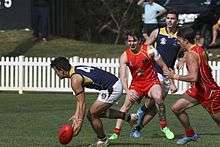
Player performing a pick up on the run
- Pick up: picking up a loose ball off the ground.
- Pill: colloquialism for the ball.[24][25]
- Ping: to attempt a shot at goal.
- Pinged: a player who is penalised by an umpire for breaking a rule.
- Playmaker: a player who directs a team play by action or deed during a game.
- "Play on!": the call made by an umpire whenever a player who is taking a mark or a free kick runs or handpasses rather than kicking over the mark; or, the call made by an umpire to alert players that a mark or free kick will not be paid, when they may be expecting that one would be paid.[26]
- Possession: When a player grabs the ball with a reasonable amount of time to dispose of it. Includes ground ball-gets, marks, handball receives, effective contested knock-ons and frees for.
- Pocket: an indicative part of the ground, equivalent to the area proscribed by an imaginary arc running from the goal post to a point on the boundary line halfway to the fifty-metre arc. There are two pockets at each end of the ground, referred to as the left and right, forward and back pockets, e.g. left-forward pocket.
- Point: the basic scoring unit. Used for both the total score (10 goals, 8 behinds, 68 points) and can be used interchangeably with behind ("The player's shot for goal missed and was only a point").[3]
- Poster: common expression for a kicked ball which hits a goal post, resulting in a behind being scored rather than a goal.
- Premiership: awarded to the winner of the Grand Final. See the flag.
- Premiership quarter: A colloquialism for the third quarter of a match.
- Premiership Window: The range of years that a team has a likely and realistic chance of winning the premiership.
- Prior opportunity: (sometimes shortened to prior) a player who has had the ball for long enough to make a reasonable attempt to dispose of it before being tackled is said to have had prior opportunity. This is important for holding the ball decisions, where a player who has had prior opportunity must dispose of the ball immediately, while a player who has had "no prior" has a few extra seconds to dispose of the ball.
- Protected zone: an imaginary corridor 10 metres to either side of a player who is taking a free kick, into which no players from either team are permitted to be.
Q
- Quarter: a period of play. Each game is divided into four quarters of equal length. Quarters in the AFL and other senior last 20 minutes plus time-on.
- Quarter-time: the gap between the first and second quarters.
R
- Rainmaker: a ball that is kicked very high up but not very far
- Raking: a kicking style that results in long kicks.[27]
.jpg)
Player reading the ball
- Reading the ball: judging the ball's movement as it flies through the air or bounces along the ground.
- Rebound: the act of moving the ball forward after winning it as the result of a turnover in the defensive end of the ground.
- Recycled player: a player unwanted by his original team who continues his career at a second club.
- Red time: the final few minutes of playing time in any quarter.
- Reported: the state of a player after an umpire has written their name into a notebook, during play, for an act that may result in the player being suspended.
- Rocket handball: a handball technique which causes the ball spins backwards in the air in the same fashion as a drop punt. It was pioneered by Kevin Sheedy and is now the most common handball technique in modern football. It is considered the most effective style of handball in terms of distance and accuracy, although it can take longer to execute than other styles.
- Rookie: a player who is on an AFL club's playing list, but who cannot play senior games unless replacing a long-term injured or retired player.
- Roost: a long kick.[28]
- Rotation: a planned interchange designed to minimise fatigue of midfielders.
- Rover: a small inside midfielder. Historically one of three distinct followers, but the term is now rarely used.[29]
- Rubbed out: colloquialism for being suspended.
- Ruck: (or ruckman) a tall player who contests the ball-up or throw-in.
- Ruck rover: a midfielder halfway between a ruck and a rover. Historically one of the three distinct followers, but now rarely used.
- Run through the mark: (or "run across the mark"), when a player runs between the player on the mark and the player who is taking a free kick. If a defending player does this, and they are not immediately following their direct opponent, a fifty-metre penalty will be awarded.

Runner (right) with his team's coach
- Runner: a club official whose job is to run onto the ground to give the players messages from the coach during play.
- Running bounce: (or simply bounce) the act of a player bouncing the football on the ground and back to himself while running, which must be done once every fifteen metres.
- Rushed behind: the concession of a behind for the opposition team. A behind which is deemed to have been deliberately rushed by a player under no pressure is penalised by a free kick, but in all other circumstances it concedes one point.
S
- Sausage roll: rhyming slang for goal, often shortened to "sausage" (also called a snag, from the Australian slang term for a sausage).
- Saw tooth: a team tactic of continually changing the direction of the ball as it advances down the field.
- Screamer: see spectacular mark.
- Season: a year of a competition.[6]
- Selling candy : see baulk.
- Set shot: an attempt to kick a goal from a mark or a free kick. See shot.[13]
- Shark: obtaining possession of the ball, often in a difficult position, particularly from the hitout of the opposing ruck.[30]
- Shepherd: a block placed on an opposing player. This can be to stop him tackling a teammate in possession of the ball, or attempting to gather it; to stop him intercepting a ball heading for goal; or just to stop him possessing the ball himself.
- Shirtfront: an aggressive front-on bump.
- Shot: an attempt to kick a goal.
- Showdown: a game between Port Adelaide and Adelaide
- Siren: a loud sound used to signal the start and end of the game, and the start and end of each quarter.[3]
- Sit: the best position from which to take a mark.
- Sledge: to trash talk an opponent.
- Slingshot: also, end to end, a goal where the ball is moved from one end of the field to the other in a short amount of time.

Player preparing to smother an opponent's kick
- Smother: the act of stopping a kick immediately after it leaves the boot. Generally undertaken with the hands or body.
- Snap: a shot at goal, usually executed under pressure from an unlikely scoring position. It is almost invariably a kick across the body (i.e., for a right footer, a kick aimed to far left) and typically exaggerates the natural tendency of the ball to drift slightly right to left from a right footer, and left to right from the left footer. It is in this way the reverse of a "checkside" or "banana".[13]
- Soccer: (verb) to kick the ball off the ground, i.e. without first taking the ball in the hands, as is the primary means of disposal in the sport of soccer.

Player takes a spectacular mark
- Spectacular mark: also known as a specky, screamer or hanger. Generally refers to the act of leaping onto another player's back or shoulders to take a high mark, usually in a contested situation.[31]
- Spell, to have a: to be interchanged off the ground.
- Spillage: occurs when a ball comes off the top of a pack of players attempting to mark a ball.
- Spoil: a punch or slap of the ball which hinders an opposition player from taking a mark.
- Spray: severe scolding of players by their coach.

Player preparing to spoil an opponent's mark attempt by punching the ball
- Spray shot: a poorly executed kick at goal that comes 'off the side of the boot' and produces a point.
- Stab shot: a kick that travels very low to the ground to a teammate. Until the 1970s this was usually a drop kick.
- Stacks on the mill: a stand-alone statement made by commentators to indicate that the ball is covered by a large pack of players on the ground and is unable to move.
- Stepladder: colloquially, the player upon whose shoulders another player jumps to take a specky.
- Sticks: see goal posts. To "find the big sticks" is to score a goal.
- Stoppage: when play stops for a ball up or a throw in.
- Substitute : an interchange player who cannot be freely interchanged, but may be brought onto the ground to replace a player for the rest of a game.
- Super goal: a goal which scores nine points instead of six, earned by kicking a goal from beyond a set distance, usually 50m in AFL pre-season competitions. Seen only in practice and exhibition games.
- Suspended: the state of a player who has been refused permission to play by a legislated tribunal. See reported.`[3]
- Sweeper: a player who plays loose across the half-back line in order to act as a link between the backline and midfield.[16]
- Switch: to move the ball laterally across the ground, hoping to find an easier path to the forward-line.
T
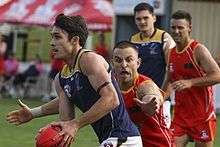
Player lunging to tackle an opponent in possession of the ball
- Tackle: the grabbing of an opposition player in possession of the ball, in order to impede their progress or to force them to dispose of the ball quickly.[6]
- Tagger: a defensive player whose task is to prevent an opposition midfielder from having an impact on the game.
- Tap: see hitout.
- Tapout: see hitout.
- Term: colloquialism for quarter.[13]
- Thin side: an imaginary area of the ground that indicates the least space occupied by the greatest number of players. See fat side.
- Third man up: (or simply third man) a player other than the nominal ruckman who unexpectedly enters a ruck contest to effect a hitout. The laws of the game were altered in 2017 to disallow this tactic.
- Three-quarter-time: the break between the third and fourth quarters.
- Throw: an illegal disposal of a ball by hand. Will result in a free kick to the opposition.
- Throw-in: see boundary throw-in.
- Time-on: time added onto the end of each quarter to compensate for time lost during general play by stoppages. The amount of time to be added on is determined by independent time-keepers who stop the game clock when indicated by the central umpires. Lower grade and lower age-group competitions will often be played without time-on.[3]
- Torpedo: (colloq. screwie, torp or barrel) a punt kick that rotates the ball around its long axis, which is aligned with the direction the ball is travelling. Regarded as the type of kick with the longest distance, but the lowest chance of being accurate.[32]
- Touch: colloquialism for possession or disposal.
- Touched: indicates that a ball was touched by another player after being kicked; such a kick cannot result in a mark, a goal, or an out of bounds on the full free kick.
- Tribunal: the judicial system of the Australian Football League where players can contest on-field charges arising from their matches. Also see AFL Tribunal
- Trip: a low tackle which will result in a free kick to the opposition. Furthermore, tripping or attempting to trip an opponent with the foot or leg will lead to a player being reported.[3]
- Turnover: the loss of possession of the ball to the opposition.
- Tunnelling: bumping an airborne player attempting a mark with the intention of unbalancing them.
U
- Umpire: one of the enforcers of the laws and adjudicators of play.
- Uncontested possession: a possession achieved without having to engage in a contest.
- Utility: Classification for a player that can play numerous roles and/or positions.
W
- Wing: an indicative area of the ground that lies between the forward and back flanks on both sides of the centre. There are only two on the ground.
- With the flight: a player who marks the ball as they run in the direction the ball is travelling.
- Wooden spoon: the mock "award" said to be received by the team finished last on the ladder at the end of a season.
- Worm burner: See Daisy Cutter.
X
Y
Z
- Zone: There are three zones identified on an AFL football field. The defensive zone is located within the 50m arc closer to the opposition's goals, the midfield zone is between the two 50m arcs and the forward zone refers to the area within the 50m closer to that team's goals.
- Zone off: the act of a defender leaving some space between theirself and their opponent. This is contrary to the normal defensive style of man-on-man.[10]
gollark: It WOULD make it easier to AND/OR them if it was a bitfield.
gollark: Thus, bitfield extraction is entirely possible.
gollark: We can create arbitrary SQL functions.
gollark: Denied.
gollark: No.
References
- Lovett, Michael, ed. (200). AFL Record Guide to Season 2005. pp. 809–811. ISBN 0-9580300-6-5.
- 2007 AFL All-Australian Team announced
- Laws of Australian Football 2008 Archived 2008-08-01 at the Wayback Machine
- Fev kicks bag in Blues win
- GrandStand Footy Unleashed: The death of the ball burster
- AFL may have dropped the ball
- Schmidt peels off a banana for Swans
- Cheers to the barrel, torpedoes find new life
- North Melbourne - Hall of Fame - see Les Foote entry
- Worsfold blames skill errors
- Triple M Foot 2007 Best on Ground Award
- "Essendon Website". Archived from the original on 24 July 2008. Retrieved 28 July 2008.
- Kangaroos keep finals hopes alive
- Rich Pickings
- "Glass to have scans". Archived from the original on 6 June 2012. Retrieved 28 July 2008.
- McLeod the answer to Crows' woes
- "Oxford Australia Word of the Month" (PDF). October 2008.
- Mr Natural (page 2)
- Tippett, Ben. "The Complete Guide To Understanding Australian Rules Football". Deadspin. Retrieved 13 December 2017.
- Power to explain breach
- Hawks in the zone
- Stevens, Mark; Can Knights plug Dons’ inside 50 leaks?; Herald Sun; 30 April 2008
- "Define jumper punching, Thomas tells AFL". The Age. 3 August 2006. Retrieved 4 May 2013.
- "Our first balloon...The Sherrin Football". Picture This Ballooning. Retrieved 19 May 2013.
- "Sherrin - Gameballs - KB". Sherrin Kangaroo Brand. Archived from the original on 19 April 2013. Retrieved 19 May 2013.
- "Part D - Section 17.1". Laws of Australian Football 2013. Australian Football League. p. 61. Retrieved 18 May 2013.
- Thirty of the best prospects prepare for this Saturday's AFL draft
- Turn the focus on our flawed favourites
- Rover and winger tie for medal
- Zebras History 1981-2001
- Vote for Monfries' speccie
- Mr Natural (page 1)
External links
| Look up Appendix:Australian rules football slang in Wiktionary, the free dictionary. |
This article is issued from Wikipedia. The text is licensed under Creative Commons - Attribution - Sharealike. Additional terms may apply for the media files.